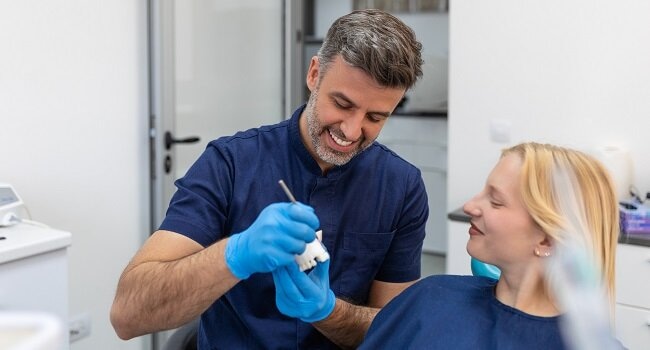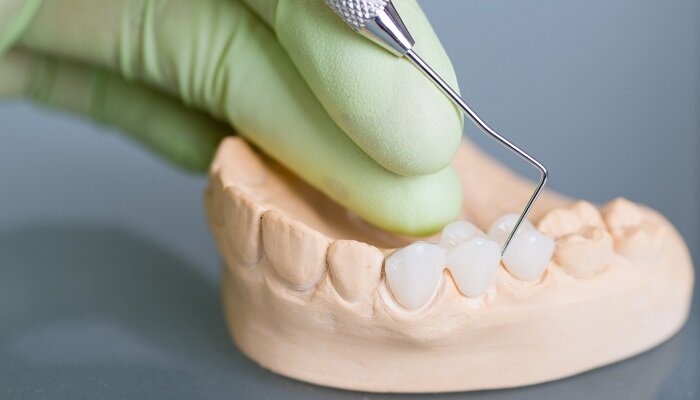In the broad spectrum of dental care solutions, dental bridges emerge as a versatile and reliable option for filling the gaps left by missing teeth. These vital prosthetics restore smiles and reinvigorate the crucial functional aspects of eating and speaking. They represent a fascinating blend of art and science, combining aesthetic appeal with the principles of dental mechanics.
Despite being a popular choice, a dental bridge calls for understanding before one embarks on the restoration journey. This comprehensive guide highlights the necessary information to help individuals chart the course toward acquiring a dental bridge with confidence and clarity.
What Is A Dental Bridge?
As the name suggests, a dental bridge bridges the gap created by one or more missing teeth. The bridge consists of two or more crowns for the teeth on either side of the gap, known as abutment teeth, and a false tooth or teeth in between. These false teeth, known as pontics, can be made from various materials, including gold, alloys, porcelain, or a combination.
Before venturing into getting a dental bridge, understanding the types available in the dental industry is crucial. There are four primary types, including the following:
- Traditional Bridges: They involve creating a crown for the tooth or implant on either side of the missing tooth, with a pontic in between.
- Cantilever Bridges: They’re used when adjacent teeth are on only one side of the missing tooth or teeth.
- Maryland Bonded Bridges: They involve metal or porcelain wings on each side of the bridge, bonded to existing teeth.
- Implant-Supported Bridges: They use dental implants as opposed to crowns or frameworks.
By knowing the different types of dental bridges, you’ll know which one will work best for your situation. But if you want to make the right decision, it’s best to consult a professional who specializes in offering dental bridge Melbourne or wherever you may be for more information.
The Benefits And Drawbacks Of A Dental Bridge
Understanding the benefits and potential drawbacks of a dental bridge is essential to knowing if it’s the appropriate dental solution for your needs. Generally, dental bridges can restore a smile and the ability to chew and speak properly. They also help maintain the shape of the face and distribute the forces in the bite correctly by replacing missing teeth. They prevent tooth shifting and align your bite to avoid bite problems and other related issues.
However, a key point to remember is that getting a dental bridge requires a commitment to maintaining oral health. Failure to keep the bridge and surrounding teeth clean can also lead to issues such as gum disease or tooth decay. Unlike implants, dental bridges may not last a long time. Lastly, some people may experience pain or discomfort after the placement, resulting in a significant inconvenience.
The Cost Of Getting A Dental Bridge
Another significant consideration is the cost. Dental bridges are a considerable investment, with prices ranging significantly depending on factors such as the materials used, the complexity of the placement, and the additional treatments required.
Although dental insurance may cover a portion of the cost, it’s important to understand the financial obligation fully. Hence, it’s best to talk to your insurance provider to know the extent of your coverage or whether you need additional insurance to cover the costs of the dental bridge.
The Process Of Getting A Dental Bridge

The process of getting a dental bridge also requires time. The procedure usually involves several visits to the dentist. During the first visit, the abutment teeth are prepared. This preparation involves recontouring these teeth by removing a portion of enamel to allow room for a crown to be placed over them.
Next, impressions of the teeth are made, which serve as a model from which the bridge, pontic, and crowns will be made. A temporary bridge will be made to wear to protect the exposed teeth and gums while the bridge is being made.
During the second visit, the temporary bridge will be removed, and the new porcelain or metal bridge will be checked and adjusted, as necessary, to achieve a proper fit. Multiple visits may be required to check the fit of the metal framework and bite.
The Side Effects Of A Dental Bridge
There are also potential side effects of dental bridge treatment. These may include sensitivity to extreme temperatures after the procedure since preparing the abutment teeth can leave them sensitive to heat and cold. This sensitivity should gradually decrease over time. There can also be a bacteria buildup due to the crowning process, making excellent oral hygiene crucial to prevent tooth decay under the bridge.
The Things To Expect After Getting A Dental Bridge
Getting a dental bridge can be complex and needs commitment. One should anticipate a few changes in eating habits initially following the placement of a dental bridge. Eating soft foods cut into small pieces is generally recommended until you become accustomed to the bridge.
Also, consider the impact of a dental bridge on speech. It’s common to experience a slight difference in pronunciation after getting a dental bridge, but this typically improves over time as individuals become used to the new dental addition.
Lastly, adjusting to dental bridges involves developing good dental hygiene habits. Keeping the dental bridge and surrounding teeth clean is critical to preventing dental issues. One recommended practice is to use a bridge floss threader that allows the removal of plaque from hard-to-reach areas around the bridge, gums, and adjacent teeth.
Conclusion
Obtaining a dental bridge is a significant decision that should not be taken lightly. It requires a commitment to maintain oral hygiene, potential changes in eating habits, and an adjustment period for speech. Therefore, if you are considering getting a dental bridge, remember the information mentioned above to figure out if it’s the right dental treatment for you.


















